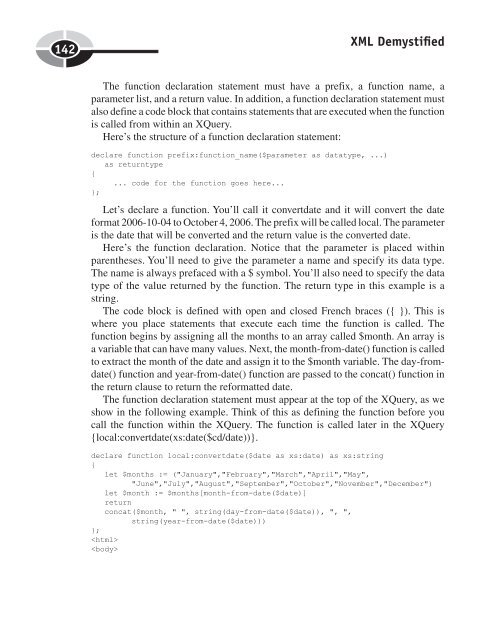You also want an ePaper? Increase the reach of your titles
YUMPU automatically turns print PDFs into web optimized ePapers that Google loves.
142<br />
<strong>XML</strong> Demystifi ed<br />
The function declaration statement must have a prefix, a function name, a<br />
parameter list, and a return value. In addition, a function declaration statement must<br />
also define a code block that contains statements that are executed when the function<br />
is called from within an XQuery.<br />
Here’s the structure of a function declaration statement:<br />
declare function prefix:function_name($parameter as datatype, ...)<br />
as returntype<br />
{<br />
... code for the function goes here...<br />
};<br />
Let’s declare a function. You’ll call it convertdate and it will convert the date<br />
format 2006-10-04 to October 4, 2006. The prefix will be called local. The parameter<br />
is the date that will be converted and the return value is the converted date.<br />
Here’s the function declaration. Notice that the parameter is placed within<br />
parentheses. You’ll need to give the parameter a name and specify its data type.<br />
The name is always prefaced with a $ symbol. You’ll also need to specify the data<br />
type of the value returned by the function. The return type in this example is a<br />
string.<br />
The code block is defined with open and closed French braces ({ }). This is<br />
where you place statements that execute each time the function is called. The<br />
function begins by assigning all the months to an array called $month. An array is<br />
a variable that can have many values. Next, the month-from-date() function is called<br />
to extract the month of the date and assign it to the $month variable. The day-fromdate()<br />
function and year-from-date() function are passed to the concat() function in<br />
the return clause to return the reformatted date.<br />
The function declaration statement must appear at the top of the XQuery, as we<br />
show in the following example. Think of this as defining the function before you<br />
call the function within the XQuery. The function is called later in the XQuery<br />
{local:convertdate(xs:date($cd/date))}.<br />
declare function local:convertdate($date as xs:date) as xs:string<br />
{<br />
let $months := ("January","February","March","April","May",<br />
"June","July","August","September","October","November","December")<br />
let $month := $months[month-from-date($date)]<br />
return<br />
concat($month, " ", string(day-from-date($date)), ", ",<br />
string(year-from-date($date)))<br />
};<br />
<br />


